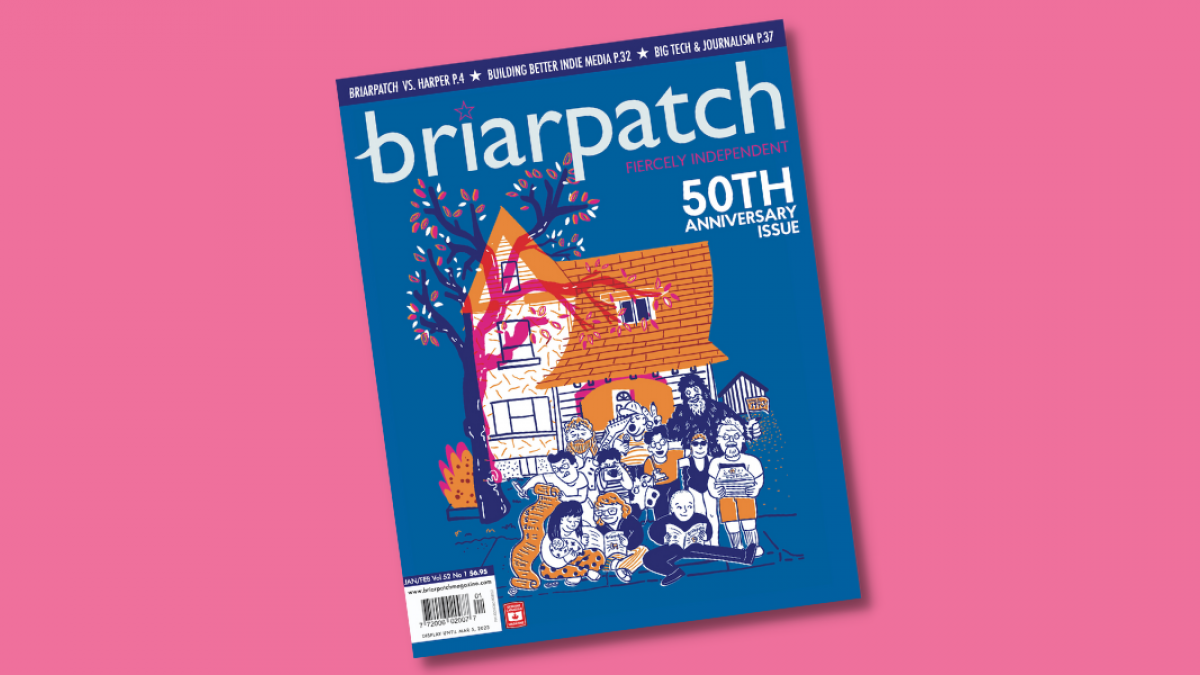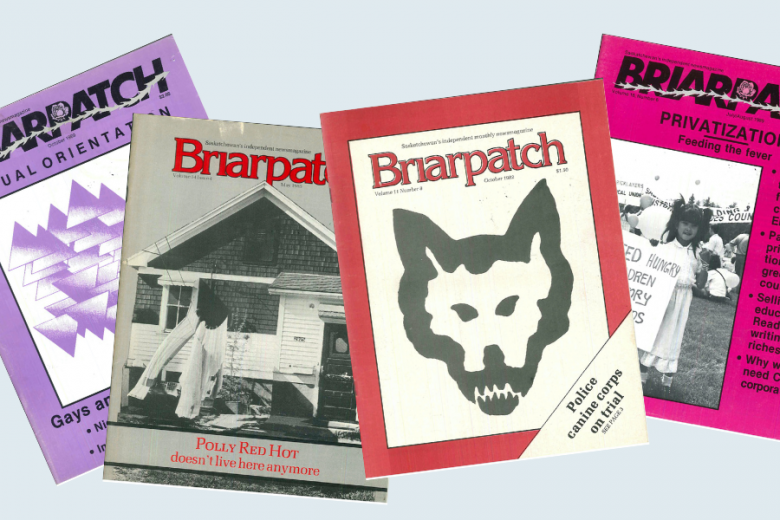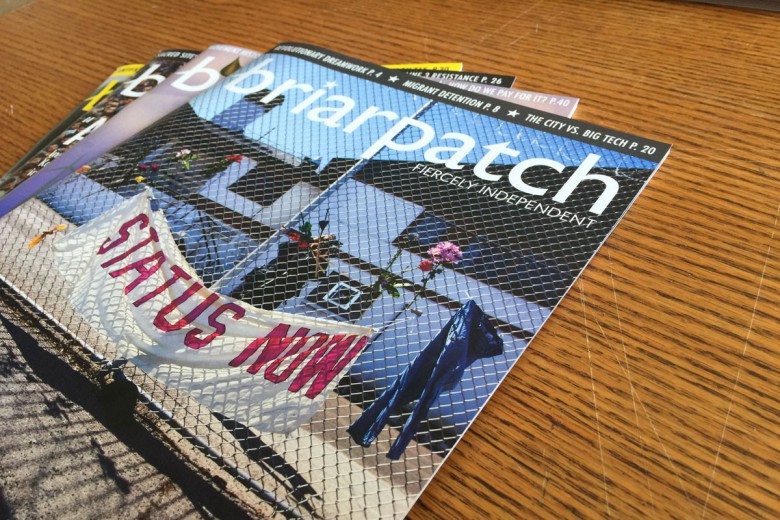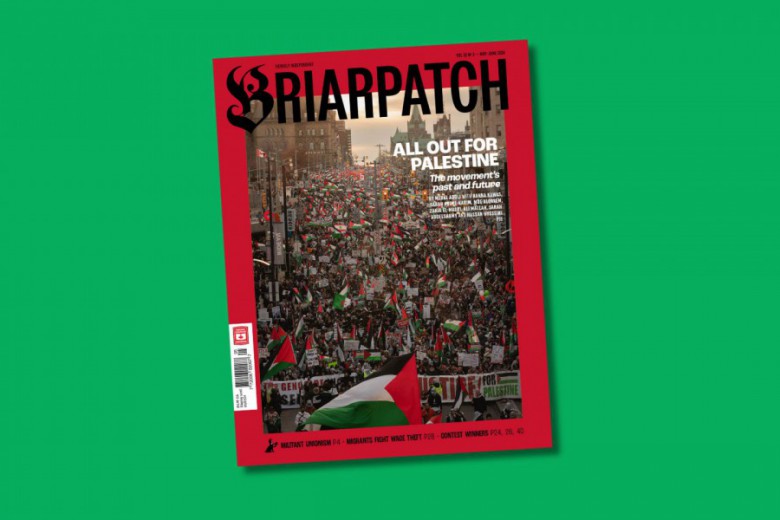When I first became Briarpatch’s editor, I was 22 years old. I had experience as a journalist and editor, but I hadn’t read much Briarpatch, and I hadn’t grown up in a leftist family. I had a lot to learn about radical politics.
In those first few years there were late nights stuffing envelopes, weekends fine-tuning drafts, and early mornings racing to finish a layout. I’m proud of what I made: four special issues (including a National Magazine Award-winning one), a new progressive publication that covers Saskatchewan, and many hard-hitting stories. But, nearly five years since I first walked into the office, I can see that this magazine made me just as much as I made it.
Briarpatch has been an important part of the political education of thousands of people before me and, I hope, countless people to come.
Briarpatch taught me that ordinary people are the ones who change the world for the better, far more reliably than celebrities or politicians. It taught me to be wary of those who would trade our liberation for their own power – whether that’s nonprofit execs or “socialist” authoritarian governments. It taught me about the long arc of anti-colonial and anti-capitalist struggle in Saskatchewan, and the people who keep up the fight against a right-wing government in its fourth term – “jamming our foot in the heavy door of history so that the full weight of neoliberal power would not succeed in slamming it shut completely,” as Naomi Klein writes.
Briarpatch is not just a collection of articles and geriatric computers; this magazine has history, and it has momentum. Its past – which includes having its funding cut by pissed-off NDP and Tory governments alike, going toe-to-toe with mining companies, and covering movements in Mexico, Palestine, and Canada – is the rudder that steers the magazine today. Briarpatch has been an important part of the political education of thousands of people before me and, I hope, countless people to come.
I’m honoured to be the one to make this special issue, which celebrates Briarpatch’s 50th anniversary. To me, it doesn’t make sense to talk about Briarpatch’s survival without talking about Canadian media as a whole – you can just look at Sara Birrell and Mike Gouldhawke’s article about New Breed to see that this magazine has always supported and leaned on other left-wing outlets. So this issue also includes articles about the broader landscape of left-wing and independent media in Canada.
Journalism is a public service, and it’s time we start acting like it – by making sure that everyone understands what’s at stake when the media gets colonized by capital.
Unless you’re a media nerd like me, you might not know much about the crises facing journalism in Canada: the few billionaires and hedge funds that own our biggest newspapers, the government funding that they lobby for and then vacuum up, the fact that for every journalist there are now 11 people working in marketing or public relations. But you might have wondered why newspapers seem to have more stories about real estate and fewer about workers; why your community paper is filling up with national, rather than local, news; why media giants are allowed to trade ownership of newsrooms and then shut them down; or why the far-right is so effectively spreading disinformation and winning new recruits. If you’re asking these questions, this is the magazine issue for you.
Journalism is a public service, and it’s time we start acting like it – by making sure that everyone understands what’s at stake when the media gets colonized by capital. This issue is by no means a comprehensive overview of media in Canada, but I hope it will explain some of the thorniest problems, and put forward a solution: democratic, non-profit media.
It’s fitting that this issue, in which I get to talk about my two great loves – Briarpatch and media literacy – is the last one I’ll make for a while. In 2023 I’m taking a one-year leave of absence from Briarpatch. I’ll be working on some new projects, resting, and contemplating Briarpatch’s future from a healthy distance. I’m so excited to welcome Sophie Jin as Briarpatch’s interim editor. Sophie has worked as Briarpatch’s assistant editor and publisher on-and-off since 2021; she helped make the Prison Abolition Issue and the Disability Justice Issue; and she has written a number of articles for Briarpatch and the Sask Dispatch. I couldn’t be more confident leaving Briarpatch in their capable hands, and I’m so excited to see what they publish in the coming year.
Happy 50th birthday, Briarpatch. We are so lucky to have this magazine. I invite you to join me in becoming a Briarpatch sustainer by going to briarpatchmagazine.com/donate. Monthly donations are the best way you can help make sure that Briarpatch is still kicking, and still fiercely independent, for generations to come.



_780_520_90_s_c1.jpg)



